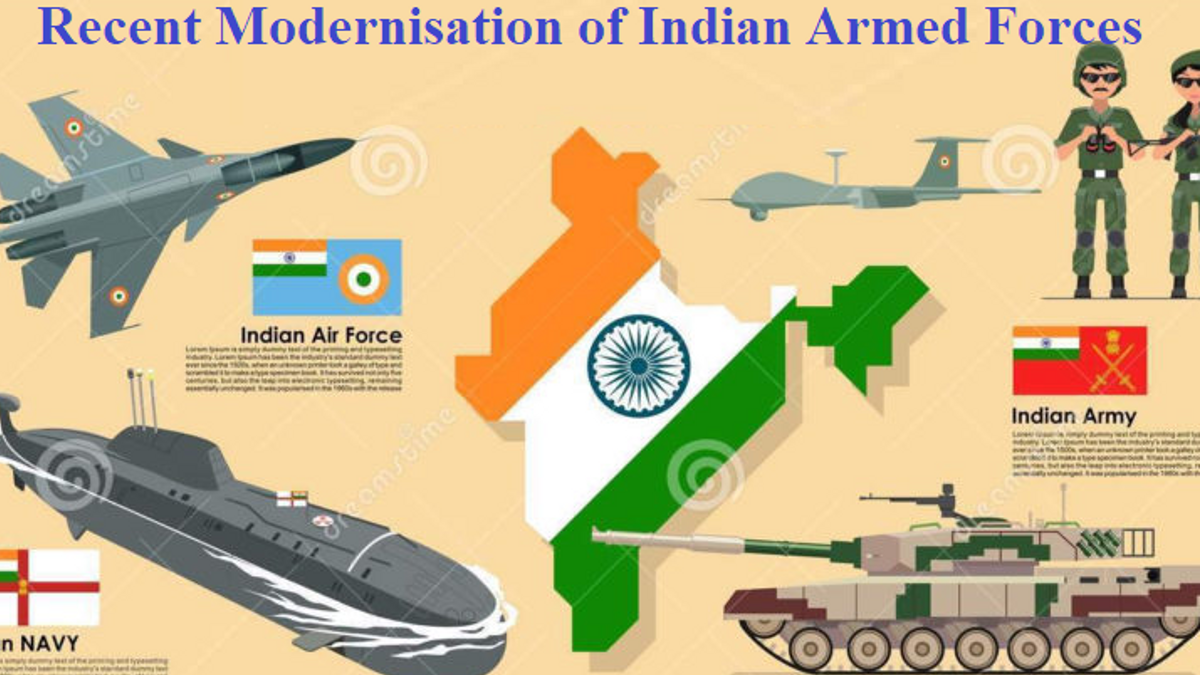
Recent Modernisation of Indian Armed Forces
Indian Armed Forces have long been ignored by their own law makers & policy makers. The result of the slackness in Indian Defence Preparedness is that we had to repeatedly face wars mounted by minos Pakistan as well as by a larger adversary, China. India had long been passive and docile to the ever-growing Chinese threats. India lacked the might to discourage or threaten the adversaries. Chinese are already in possession of our vast lands in Akai Chin and through further encroachments towards Depsang Plains and Daulat Beg Oldie airstrip in 2013. Our defence planners were by and large satisfied comparing Indian defence capabilities vis-a-vis Pakistan. They neglected development of our extensive border areas and military capabilities with China till we faced Doklam, Pangong and then Galwan. This was the time our Armed Forces realised the lopsided modernisation plan. We had no assault rifles other than Insas. We had no roads and allied infrastructures in the border areas all along LAC. We produced no advanced ammunitions for our service requirements.
Defence services modernisation plan had taken a back-seat in the prior 3 decades ever since Bofors scam. In a short span of 7 yrs, Modi Govt has undertaken several steps towards the modernisation of the Armed Forces and the biggest positive out of it is that he has put indigenisation, make-in-India and ‘self-reliant India’ plans for the manufacture and production of defence equipment put in rolling. The modernisation plan has taken-off from the year 2015-16 with a jump of nearly 96K Cr annual budget and stood at 471.4K Cr last year (Year 2020-21). This is more than double of what stood at 2014-15, yet the overall allocation is just over 2% of the GDP what used to be nearly 2.5% during UPA’s time. It is because of the huge growth of the GDP which grown up from UPA’s time.
Fighter aircraft, heavy artillery, anti-submarine aircraft, Aircraft Carriers, Submarines, stealth frigates… to the soldiers fighting guns, India’s armed forces are being strengthened like never before. The Modi govt has also drastically improved the living conditions of the soldiers, especially in remote and inhospitable areas. What’s more, many of these armaments and equipment are being manufactured indigenously under Prime Minister Narendra Modi’s flagship ‘Make in India’ initiative.
Although UPA govt of India in their span from 2004-14 made numerous purchases of military equipment, there was hardly any without ‘someone’ having taken substantial commission. There are allegations of ‘Bhandari-Vadra group’ being involved in most if not all purchases. It is also worth taking note that most purchases that could have provided the Armed Forces with tactical or Strategic advantage, was kept under a deep freeze for years. For reasons best known to the UPA govt, they dragged their feet in modernisation that the Armed Forces needed the most, over a long period. The following are 6 such procurements: -
After Modi Govt came to the power at the centre in 2014, India saw a plethora of Defence Acquisitions incl those put in cold storage during UPA Govt. All defence experts had opined unanimously that if India has to become major regional and global power, it must have its own defence hardware. The emphasis was on Made-in-India as well as make in India. People of India will ever remain grateful to the Modi Govt who made it possible for the Indian R&D to come to performance levels with their substitutes for the high-cost imported military hardware. This included indigenous Arjun Tank for Army, Aircraft Carriers & Submarines for navy and Tejas Aircraft for the IAF which had been side-lined from the lists of procurements during the UPA govt.
Modi Govt did no magic but assisted the developing agencies overcome the hurdles and bottlenecks coming in way of meeting the performance requirements. The govt only facilitated global domain experts to interact to resolve the issues. Today, Arjun Tank Mk-1A has excellent features with 71 major and user-driven upgrades. Features like increased mobility, Fire-power accuracy and its enhanced survivability make it world-class and will immensely benefit the Indian Army. Many critics of indigenous technologies and self-reliance make the mistake of comparing Arjun Mk-1ATank with T-70MI, German Leopard-2 and French Leclerc. They forget that any indigenous equipment will have in-house upgradations, modifications to continuously improve upon and that marginally higher cost is paid to the companies within India which is for the benefits of Indians.
Similarly, Tejas aircraft with 4th Generation avionics, additional hardware to carry more weapons, added ECM measures, OBOGS and some other features is at par with the world-best in the category. Development of Aero-engines has been the sore point in the many decades of R&D. Kavery project disappointed all. However, it is believed that GTRE is closing the performance gap. The day India has its own aero-engine, it will be a formidable air power to reckon with.
This govt also made some sweeping changes in the indigenous capabilities in Naval Vessels building of Naval Ships, Submarines or even aircraft carrier. In the last 7 yrs, Modi govt has given enough projects to own shipyards with specialised technical consultants from abroad to design and develop the state-of-the-art naval vessels. Indian Navy ignored by the previous govt, is making rapid strides to cover the lost grounds and prepare itself to have a leading role in the Indo-pacific as well as Arabian sea.
Besides the Services-specific war machines, India has also made progress in the Air Defence Systems that include Radars, Communication Systems and Air & Ground Defence projectiles and missiles. While INDRA Radar developed by DRDO was already in service before 2014, it was only a representative of indigenous systems. The major push has taken place with OEM supported enhanced serviceability guarantees in recent years. Today, INDRA I & II, Rajendra and Rohini Radars are increasingly being installed by both IAF and Army (as well as by Civil Airports), some with even possessing ECM and ECCM capabilities. Swathi weapon locating radar is another new acquisition for the Army. An indigenously developed Active Electronically Scanned Array (AESA) radar is being fitted in some of the frontline fighter aircrafts, making India one of the few countries to have an indigenous force-multiplier that lies at the heart of electronic warfare, long-range missiles and long-distance, precision-guided ammunition delivery. GSAT-7A based advanced communication system for the IAF is another feather in our cap for Atmnirbhar plan. On the other hand, DRDO in recent years have developed lethal precision guided missiles against enemy aircrafts, Ships & Submarines as well as against the enemy ground-based assets, both static and movable. Indian Ordnance Factories have been reorganised to meet all munition requirements of the Armed Forces that were largely imported till now.
India is self-reliant in its Missile Systems both with conventional and nuclear warheads. It has a series of missiles…Prithvi, Agni, Brahmos, Nirbhay and some more. The range of the missiles are from 290 Km to 12,000 Km. The range is further augmented by its capabilities to be launched from all platforms be it Ground, Aircraft and Under-water Ship/Submarines. These missiles have capabilities for Air-to-Air, Air-to-Ground, Air-to-Waters (& Underwater); Surface to Air, Surface to Surface, Surface to Waters (& Underwater); Water surface to – Air – waters - surface. India also has Low Level Radar avoiding Missiles to knock out high value enemy assets.
The fruits of the govt effort in the indigenous war-machines are visible now that is saving foreign exchange worth 10s of billions of dollars. Also, most if not all foreign purchases had a clause for make-in-India or an ‘Offset clause’. MoD signed 182 Defence procurement deal from 2015-18 with 62 contracts for Navy, 79 for Army and 41 contracts were signed for the IAF all totalling Rs 2,49,755 Cr. Most of these equipment have provided our Armed Forces with a distinct Tactical/Strategic advantages.
The list of major Equipment procurement/approved by Modi govt in the last 7 yrs are given below:-
Any world military power that claims to be self-reliant and advanced, have histories of at least five ‘5-year plans’ of intense efforts in achieving its goal. India has started its march in self-reliance in 2015. How long it takes for its own ‘Atm-Nirbhar’ goals, remains to be seen. However, if no corrupt union govts or those having military sabotaging objectives come at the centre, India should become a global power in the next 20 yrs or so.
Conclusion
Having suffered lack of any credible modernisation bid of military hardware for more than 3 decades, Indian Armed Forces has received a substantial face-lift with well-planed procurement policies heading towards self-reliant capabilities for all its 3 services. Modi Govt has put the Indian Defence manufacturers on a path of making India a global military power. India is no longer the biggest importer of defence equipment and has already started exporting with substantial growth potential. India is readying itself to meet the current challenges not only on its two frontiers with hostile neighbours but also across its vast coastal lines and changing global power-equations with emerging new situations. The advanced military hardware will also find many buyers.




